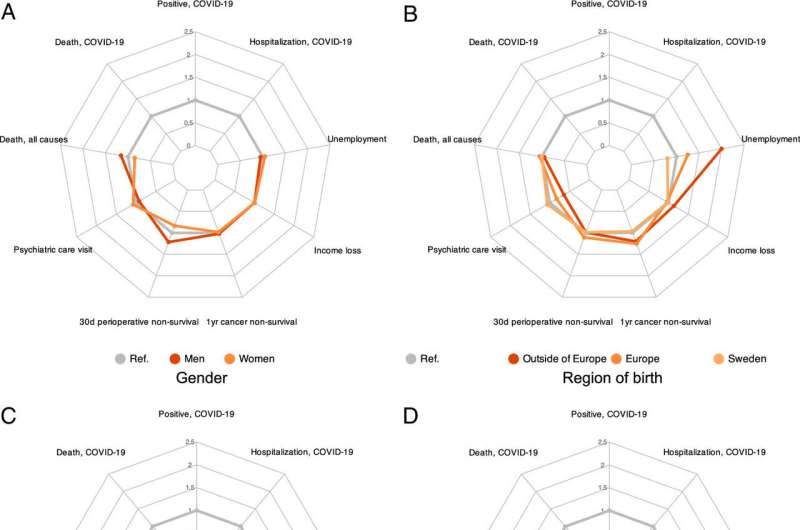This article has been reviewed according to Science X's editorial process and policies. Editors have highlighted the following attributes while ensuring the content's credibility:
fact-checked
peer-reviewed publication
trusted source
proofread
COVID-19 imposed new burdens on already disadvantaged groups and left pre-existing social inequalities in place: Study

An article by Stockholm University researchers, published in the Proceedings of the National Academy of Sciences (PNAS), relies on data for the entire Swedish population and uncovers how the COVID-19 pandemic created new social inequalities and affected existing inequalities.
The researchers present two new findings:
- Disadvantaged groups—those with low incomes, low education, and born outside of Europe—suffered the most, not just from severe COVID-19 disease and death, but from the pandemic's indirect effects: worse general health, reduced access to medical care, and economic strain.
- The structure of social inequalities that prevailed in the years before the pandemic remained in place during the first two years of the pandemic (2020 and 2021).
The study is part of SWECOV, a larger project on the causes and consequences of the pandemic, led by one of the authors, Professor Torsten Persson.
"Our results confirm that pandemic burdens were not shouldered equally," says Adam Altmejd, one of the co-authors. "Socially vulnerable individuals faced higher risks not just to fall seriously sick or die from COVID-19, but also to suffer from lower income, lose their job, not have a cancer diagnosed, or not get an operation."
While it is known that different aspects of the pandemic struck harder against some groups than others, it has been hard to measure the comprehensive impact on inequality, because of the disparate methods and measures employed by different researchers in different disciplines.
The researchers address this knowledge gap. They use the same method to measure the relative risks to experience not just SARS-CoV-2 infection, COVID-19 hospitalization and death, but additionally six indirect negative life outcomes, reflecting general health, economic strain, and access to medical care. They also do so for different social groups—people with different gender, education, income, and world region of birth.
"The inertia in social inequalities is particularly striking," added author Olof Östergren, "Our research underscores the resilience of structural inequalities in Sweden, even in the wake of an unprecedented health crisis that originated elsewhere."
More information: Adam Altmejd et al, Inequality and COVID-19 in Sweden: Relative risks of nine bad life events, by four social gradients, in pandemic vs. prepandemic years, Proceedings of the National Academy of Sciences (2023). DOI: 10.1073/pnas.2303640120





















